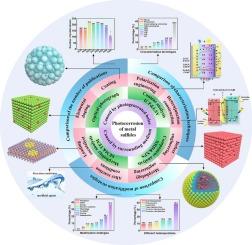Photocorrosion of metal sulfides: Mechanism, characterization, anti-photocorrosion strategies and solar catalysis applications
IF 23.5
1区 化学
Q1 CHEMISTRY, INORGANIC & NUCLEAR
引用次数: 0
Abstract
Metal sulfides (MSs) have emerged as promising photocatalysts owing to their tunable electronic band structure, robust visible-light absorption properties, and exceptional redox activity. However, their practical applications are severely hampered by photocorrosion, which is primarily attributed to photogenerated holes and interactions with the surrounding medium. While significant efforts have been dedicated to enhancing their stability and catalytic activity through various modification strategies, a comprehensive understanding of the photocorrosion mechanisms, characterization techniques, and anti-photocorrosion approaches remains unclear. This review provides an in-depth analysis of the current advances in addressing photocorrosion in MSs. A systematic overview of diverse anti-photocorrosion strategies is presented, including elemental doping, defect engineering, cocatalyst incorporation, protective layer deposition, polarization engineering, heterojunction, morphological optimization, and reaction medium modulation. Additionally, a thorough discussion of advanced in-situ/ex-situ characterization, such as scanning electron microscopy (SEM), transmission electron microscopy (TEM), X-ray diffraction (XRD), Raman, X-ray photoelectron spectroscopy (XPS), inductively coupled plasma (ICP), and electron spin resonance (ESR), is provided to evaluate photocorrosion processes. The comparative advantages and limitations of each strategy and characterization tool are critically discussed, offering valuable insights for the rational design of highly efficient and durable MSs photocatalysts. This review aims to deepen the fundamental understanding of photocorrosion mechanisms and provide feasible guidelines for advancing the practical application of MSs in photocatalytic systems.

金属硫化物的光腐蚀:机理、表征、抗光腐蚀策略和太阳能催化应用
金属硫化物(MSs)由于其可调谐的电子能带结构、强大的可见光吸收性能和优异的氧化还原活性而成为有前途的光催化剂。然而,它们的实际应用受到光腐蚀的严重阻碍,这主要归因于光产生的孔和与周围介质的相互作用。虽然人们已经通过各种改性策略致力于提高其稳定性和催化活性,但对光腐蚀机制、表征技术和抗光腐蚀方法的全面理解仍不清楚。本文综述了近年来国内外在纳米材料光腐蚀方面的研究进展。系统概述了各种抗光腐蚀策略,包括元素掺杂、缺陷工程、助催化剂掺入、保护层沉积、极化工程、异质结、形态优化和反应介质调制。此外,深入讨论了先进的原位/非原位表征,如扫描电子显微镜(SEM),透射电子显微镜(TEM), x射线衍射(XRD),拉曼,x射线光电子能谱(XPS),电感耦合等离子体(ICP)和电子自旋共振(ESR),以评估光腐蚀过程。讨论了每种策略和表征工具的比较优势和局限性,为合理设计高效耐用的MSs光催化剂提供了有价值的见解。本文综述旨在加深对MSs光腐蚀机理的基本认识,为推进MSs在光催化体系中的实际应用提供可行的指导。
本文章由计算机程序翻译,如有差异,请以英文原文为准。
求助全文
约1分钟内获得全文
求助全文
来源期刊

Coordination Chemistry Reviews
化学-无机化学与核化学
CiteScore
34.30
自引率
5.30%
发文量
457
审稿时长
54 days
期刊介绍:
Coordination Chemistry Reviews offers rapid publication of review articles on current and significant topics in coordination chemistry, encompassing organometallic, supramolecular, theoretical, and bioinorganic chemistry. It also covers catalysis, materials chemistry, and metal-organic frameworks from a coordination chemistry perspective. Reviews summarize recent developments or discuss specific techniques, welcoming contributions from both established and emerging researchers.
The journal releases special issues on timely subjects, including those featuring contributions from specific regions or conferences. Occasional full-length book articles are also featured. Additionally, special volumes cover annual reviews of main group chemistry, transition metal group chemistry, and organometallic chemistry. These comprehensive reviews are vital resources for those engaged in coordination chemistry, further establishing Coordination Chemistry Reviews as a hub for insightful surveys in inorganic and physical inorganic chemistry.
 求助内容:
求助内容: 应助结果提醒方式:
应助结果提醒方式:


